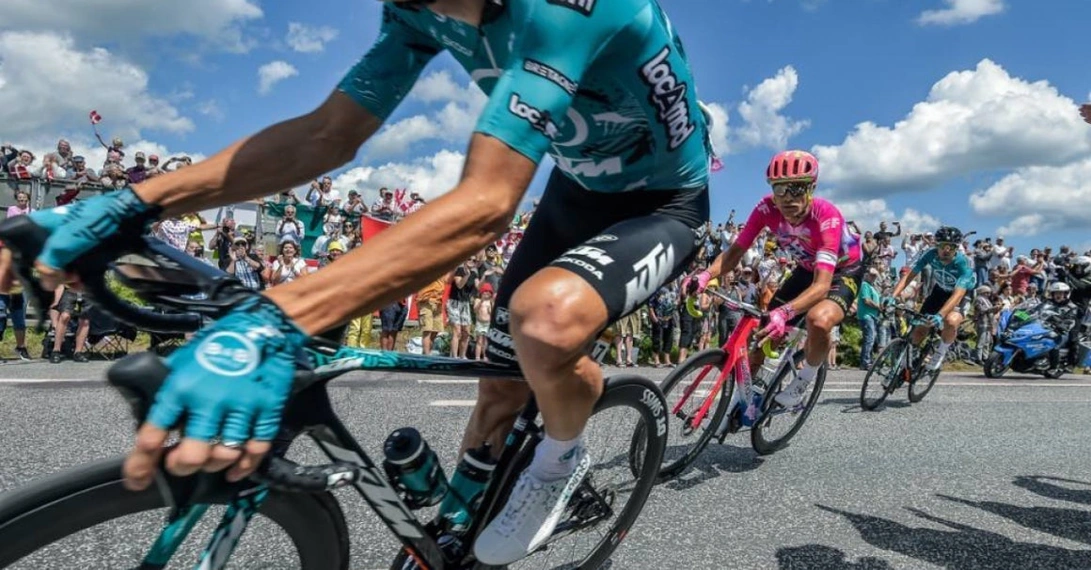The Tour de France is a business tour de force

Without question the Tour de France is one of the biggest sporting events of the year. From Berlin to Bahrain and stateside to Down Under, billions from around the world follow the Tour every summer. That viewership is growing is even more impressive when considering it was nearly derailed altogether by the doping scandal of the late 90s and early 00s. It’s not only overcome the scandal, but it’s now hitting its stride. Today, we’re taking a look at how some clever companies are getting their marketing into gear, just how intense audience engagement with the Tour is and why we could be on the verge of a new golden age of cycling thanks to Netflix.
In the late-90s and early 00s, coverage of the Tour was booming. Aerial shots of riders snaking through the French countryside or scaling the alps dominated televisions around the world. However, rumblings of widespread doping grew louder, eventually coming to a head in a widespread doping scandal that saw previous winners stripped of their titles, issued lifetime bans and forced into disgraced exile. The most-prominent figure was Lance Armstrong, who forfeited all seven of his titles, but other cycling stars including Floyd Landis, Alberto Contador and Jan Ulrich, were also caught and banned. In short, from the late 90s to the mid-00s, doping was widespread and systematic—and cycling’s, and the Tour’s, reputations were tarnished.
On your marks, get set, Netflix
The Tour, however, kept plugging along and the business side of things did, too. And business is poised for a further boom: A Netflix team is currently riding along during this year’s race filming a “Drive to survive” style documentary. If the documentary is able to attract younger audiences and amplify the Tour’s profile and have anything near the impact on the Tour that its counterpart had on F1, then we could be on the cusp of a golden age of cycling.
Whether or not the Tour returns to its former stature, it was, is and remains among the top sporting events for marketers. Tour organizers have long-since implemented significant global expansion plans. This year, for example, the start of the tour, the Grand Départ, took place in Copenhagen—the furthest north in its history. The host city actually loses money on the event—but the media attention for politicians and the city make it a winning proposition. Usually, at least. In the case of Düsseldorf, they spent nearly EUR 16m to host the Grand Départ in 2017 and ended up losing EUR 8m, as fewer sponsors and companies in Germany wanted to participate than originally planned.
Not surprising when you consider that the prime real estate for sponsors is on the jerseys of cyclists. The Dr. Wolff Group recently renewed its role as sponsor of the Alpecin-Deceuninck cycling team for an additional four years. To further boost engagement with the sport and the team, Dr. Wolff launched the Ride Club platform, which is aimed at hobby cyclists. Furthermore, the Alpecin-Deceuninck team hopes to have a very important asset in its ranks: a star with social media power in Dutch cyclist Mathieu van der Poel.
PROS behind the mic
On Instagram alone, van der Poel has nearly 900,000 followers, all of whom can follow along as he races, trains and relaxes—all while wearing his Alpecin jersey. The marketing power of van der Poel is also a boon to people beyond Dr. Wolff HQ in Bielefeld. In nearly every post of van der Poel, you’ll not only see his jersey, but also his bike. By Canyon. Also a German brand, Canyon is the official bikemaker for three teams at this year’s Tour.
But even mediocre cyclists who’ve enjoyed only moderate success on the professional circuit have considerable reach on social media. One such example is Rick Zabel, a professional cyclist from Germany, whose primary role is that of “domestique” as opposed to a sprinter like his father, is one of the more-famous cyclists in Germany. At this year’s Tour de France, he’s not even competing, but commenting for German broadcaster ARD. That position has helped him amass a following of nearly 150k on Instagram. Furthermore, he has leveraged his fame into a successful podcast called Plan Z.
EUR 200m revenue from the Tour?
“Many individual athletes have begun achieving financial gain independent of any sporting success by building up their social media profiles and amassing a network,” Felix Appelfeller from “Jung von Matt Sports” recently told German daily FAZ. Jung von Matt Sports provides, among other things, consulting services on sponsoring matters. This reach not only helps the cyclists, but also the Tour itself, as here fans stay locked in and engaged with cyclists, their lives and the sport year-round, whereas they used to only pay attention for a few weeks during the Tour de France.
There are no signs of slowing either. Amaury Sport Organisation is rumored to generate between EUR 150m and 200m from the Tour de France alone. The organization, which also belongs to Amaury, who also owns French sports publication “L’Equipe,” declines to provide exact figures. The majority of growth on the Tour, like so many other things, is found in Asia—a fact a brand like Alpecin would figure to be well aware of. Then there is the not-so-small matter of 100 channels broadcasting the Tour in 190 countries. Per Tour, there are approximately 7800 hours of live footage broadcast around the world. There is no other sporting event that can claim that kind of footage intensity in such a small timeframe. The doping scandals of the past seem to be forgotten.























